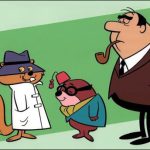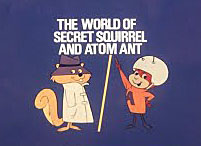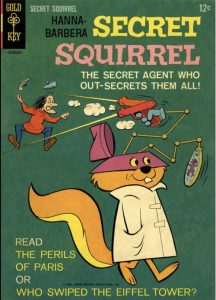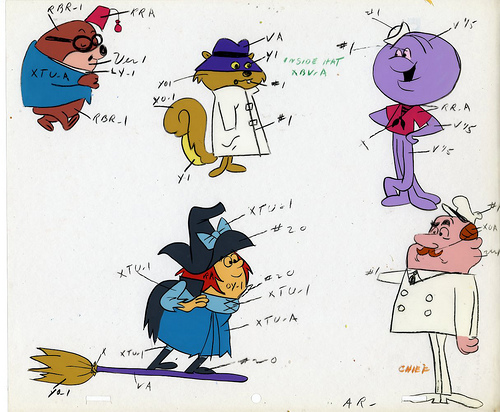



Audiences who flocked to see the latest entry in the Mission: Impossible franchise last weekend (The Final Reckoning) could see that being a secret agent is a dangerous gig.
As death-defying as Tom Cruise’s Ethan Hunt character is, he never had to do all that he does with a bushy tail – Secret Squirrel blazed that trail — and did his own stunts, too!
Hanna-Barbera’s parody of the secret agent/spy genre, which exploded in popularity in the sixties thanks to the James Bond films, celebrates its 60th anniversary later this year. Secret Squirrel, decked out in his white trench coat and peering out through eye holes in his purple fedora, was the picture of the prototypical spy, and his adventures are the stuff that Saturday morning memories are made of.
“Super spies like James Bond, and hapless detectives, like Inspector Clouseau, were at the top of their popularity in the mid-sixties,” said Funtastic World of Hanna and Barbera host and Hanna-Barbera: The Recorded History author, Greg Ehrbar. “1965 gave us Get Smart, a spoof; The Wild, Wild West, a western James Bond; the original Avengers imported from Britain with the breakthrough Emma Peel played by Diana Rigg; and Honey West, an American version of The Avengers. Kids loved the genre, so Hanna-Barbera gave us a gadget-laden squirrel fighting super villains that was perfect for cartoons.”
 The character made his first appearance in the one-hour, prime-time special, The World of Secret Squirrel and Atom Ant, which aired on NBC on September 12, 1965. This was a promotional special for the two new Saturday morning series that would be debuting that fall on the network as Hanna-Barbera’s first animated series created especially for Saturday morning.
The character made his first appearance in the one-hour, prime-time special, The World of Secret Squirrel and Atom Ant, which aired on NBC on September 12, 1965. This was a promotional special for the two new Saturday morning series that would be debuting that fall on the network as Hanna-Barbera’s first animated series created especially for Saturday morning.
A combination of live-action and animated sequences, the special prominently featured Bill Hanna and Joseph Barbera. In the special, they even arrive at their studio in grand style by helicopter. The show allowed audiences at home to get to know the two men who would be the most successful players in television animation for decades to come.
 “It was Hanna-Barbera’s first primetime network special,” said Greg. “Like 1964’s syndicated Here Comes a Star, which introduced Magilla Gorilla, it offered a chance to see Bill, Joe, and their studio onscreen. Their first animated prime time network special came a year later — Alice in Wonderland, or “What’s a Nice Kid Like You Doing in a Place Like This?”
“It was Hanna-Barbera’s first primetime network special,” said Greg. “Like 1964’s syndicated Here Comes a Star, which introduced Magilla Gorilla, it offered a chance to see Bill, Joe, and their studio onscreen. Their first animated prime time network special came a year later — Alice in Wonderland, or “What’s a Nice Kid Like You Doing in a Place Like This?”
The Secret Squirrel Show debuted on October 2, 1965 (preceded by The Atom Ant Show). It centered on the title character, “Agent 000,” who reports into a secret agency headed by Double-Q. He accepts his missions and heads off with his sidekick, Morocco Mole.
With writing from animation legends, such as Michael Maltese, Warren Foster, Tony Benedict, and Dalton Sandifer, Secret Squirrel offered some creative and sharp situations and satire.
In addition to exaggerated spy gadgets, like a car that could fold into a suitcase and the ability to disguise himself as anyone or anything, Secret Squirrel could open his trenchcoated to reveal every type of tech from a rocket to a miniature TV set.
Then, there were the outlandish villains that ranged from Yellow Pinkie (a clever take on Bond’s Goldfinger), performed by Paul Frees in a great Sydney Greenstreet imitation, and the Masked Granny, a kindly grandma in disguise (voiced by Jean Vander Pyl) who came equipped with a knitting bag of tricks.

A color guide used by the cel painters on SECRET SQUIRREL
As was standard for Hanna-Barbera series of this era, The Secret Squirrel Show comprised three cartoon-short length segments. In addition to Secret Squirrel, there was Squiddly Diddly, which told of the misadventures of the title character. This squid resides at the Bubbleland theme park and constantly causes trouble for Chief Winchley, who is in charge of the park.
Another segment of the show was Winsome Witch. On Greg’s H-B podcast, Jean Vander Pyl’s son Roger DeWitt recalled Winsome Witch as one of her favorite voices other than Wilma Flintstone. Well-meaning but prone to mishaps, Winsome Witch has the distinction of being the first female lead character in an animated TV series.
 In addition to Vander Pyl, a cast of some of animation’s greatest voice actors brought these colorful characters to life, including none other than Mel Blanc as Secret Squirrel, with Paul Frees, bringing his renowned Peter Lorre impersonation to Morocco Mole. “Frees recorded a Spike Jones version of “My Old Flame” using the Lorre impression,” Greg added. “On Jones’ radio show, the real Lorre faced off with Frees in person!”
In addition to Vander Pyl, a cast of some of animation’s greatest voice actors brought these colorful characters to life, including none other than Mel Blanc as Secret Squirrel, with Paul Frees, bringing his renowned Peter Lorre impersonation to Morocco Mole. “Frees recorded a Spike Jones version of “My Old Flame” using the Lorre impression,” Greg added. “On Jones’ radio show, the real Lorre faced off with Frees in person!”
Frees also voiced Q, as well as Squiddly Diddly, and John Stephenson voiced Chief Winchley. Other voices on the show included stalwarts like Don Messick, Henry Corden, Allan Melvin, and Janet Waldo.
Later in the season, NBC combined the three-cartoon series into the six-cartoon, hour-long Atom Ant/Secret Squirrel Show. Greg continues: “When the shows were separated again for NBC’s 1966 lineup, Atom Ant lasted another season, but Secret Squirrel was trounced by the double-punch of a new Hanna-Barbera series, Frankenstein, Jr. and The Impossibles, and the first Rankin/Bass Saturday morning series, The King Kong Show. The Hillbilly Bears cartoons became part of The Banana Splits Show in 1969, and when The Banana Splits and Friends came to syndication in the late seventies, both the Atom Ant and Secret Squirrel shows returned as part of the package.”
A re-boot surfaced in 1993, Super Secret Secret Squirrel, as part of the 2 Stupid Dogs show. In addition to a re-design, the characters were now voiced by Jess Harnell as Secret Squirrel and Jim Cummings as Morocco Mole.
Still, sixty years later, the original Secret Squirrel Show stands as a great example of what Hanna-Barbera did best: holding a mirror up to pop culture and bringing it to life for kids on Saturday morning.